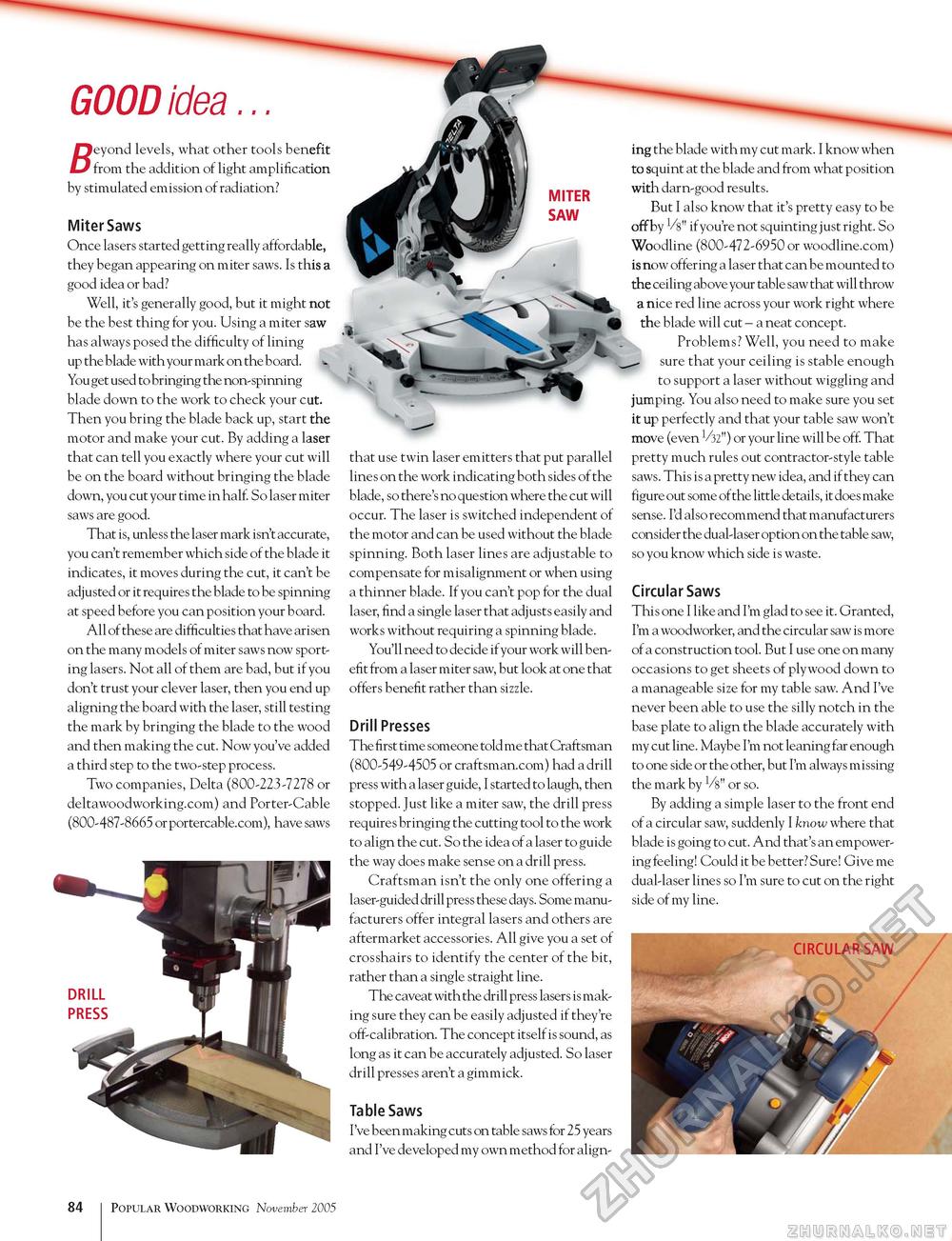Popular Woodworking 2005-11 № 151, страница 87
GOOD idea... neyond levels, what other tools benefit U from the addition of light amplification by stimulated emission of radiation? Miter Saws Once lasers started getting really affordable, they began appearing on miter saws. Is this a good idea or bad? Well, it's generally good, but it might not be the best thing for you. Using a miter saw has always posed the difficulty of lining up the blade with your mark on the board. ^ You get used to bringing the non-spinning blade down to the work to check your cut. Then you bring the blade back up, start the motor and make your cut. By adding a laser that can tell you exactly where your cut will be on the board without bringing the blade down, you cut your time in half. So laser miter saws are good. That is, unless the laser mark isn't accurate, you can't remember which side of the blade it indicates, it moves during the cut, it can't be adjusted or it requires the blade to be spinning at speed before you can position your board. All of these are difficulties that have arisen on the many models of miter saws now sporting lasers. Not all of them are bad, but if you don't trust your clever laser, then you end up aligning the board with the laser, still testing the mark by bringing the blade to the wood and then making the cut. Now you've added a third step to the two-step process. Two companies, Delta (800-223-7278 or deltawoodworking.com) and Porter-Cable -487-8665 or portercable.com), have saws that use twin laser emitters that put parallel lines on the work indicating both sides of the blade, so there's no question where the cut will occur. The laser is switched independent of the motor and can be used without the blade spinning. Both laser lines are adjustable to compensate for misalignment or when using a thinner blade. If you can't pop for the dual laser, find a single laser that adjusts easily and works without requiring a spinning blade. You'll need to decide if your work will benefit from a laser miter saw, but look at one that offers benefit rather than sizzle. Drill Presses The first time someone told me that Craftsman (800-549-4505 or craftsman.com) had a drill press with a laser guide, I started to laugh, then stopped. Just like a miter saw, the drill press requires bringing the cutting tool to the work to align the cut. So the idea of a laser to guide the way does make sense on a drill press. Craftsman isn't the only one offering a laser-guided drill press these days. Some manufacturers offer integral lasers and others are aftermarket accessories. All give you a set of crosshairs to identify the center of the bit, rather than a single straight line. The caveat with the drill press lasers is making sure they can be easily adjusted if they're off-calibration. The concept itself is sound, as long as it can be accurately adjusted. So laser drill presses aren't a gimmick. Table Saws I've been making cuts on table saws for 25 years and I've developed my own method for align ing the blade with my cut mark. I know when to squint at the blade and from what position with darn-good results. But I also know that it's pretty easy to be offby Vs" if you're not squinting just right. So Woodline (800-472-6950 or woodline.com) is now offering a laser that can be mounted to the ceiling above your table saw that will throw a nice red line across your work right where the blade will cut - a neat concept. Problems? Well, you need to make sure that your ceiling is stable enough to support a laser without wiggling and jumping. You also need to make sure you set it up perfectly and that your table saw won't move (even V32") oryourline will be off. That pretty much rules out contractor-style table saws. This is a pretty new idea, and if they can figure out some of the little details, it does make sense. I'd also recommend that manufacturers consider the dual-laser option on the table saw, so you know which side is waste. Circular Saws This one I like and I'm glad to see it. Granted, I'm a woodworker, and the circular saw is more of a construction tool. But I use one on many occasions to get sheets of plywood down to a manageable size for my table saw. And I've never been able to use the silly notch in the base plate to align the blade accurately with my cut line. Maybe I'm not leaning far enough to one side or the other, but I'm always missing the mark by V8" or so. By adding a simple laser to the front end of a circular saw, suddenly I know where that blade is going to cut. And that's an empowering feeling! Could it be better? Sure! Give me dual-laser lines so I'm sure to cut on the right side of my line. CIRCULAR SAW 84 Popular Woodworking November 2005 |








